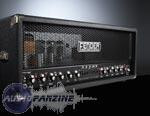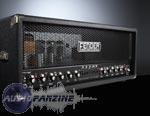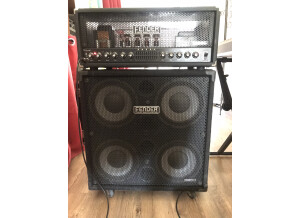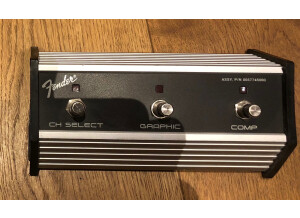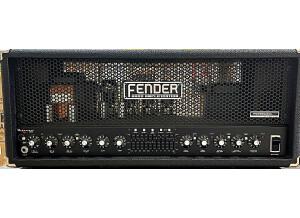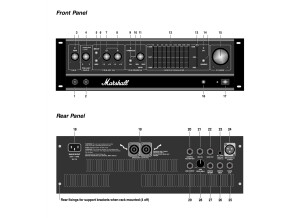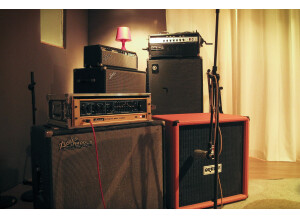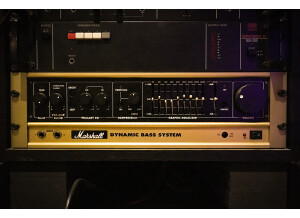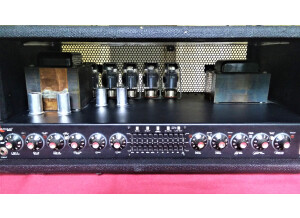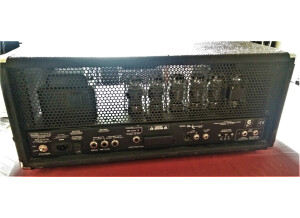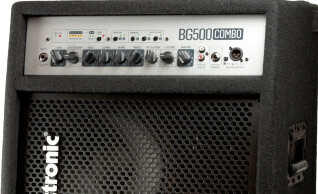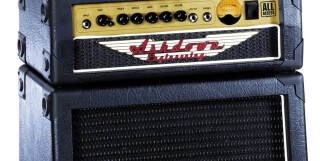Acheter neuf Fender Bassman 300 Pro
- Music Store En stock / Livré en 72h 2 969,00 €
- Effect on Line Pas de stock / NC 2 959,00 €
Annonces Bassman 300 Pro
Alerte nouvelle annonceImages
Fiche technique
- Fabricant : Fender
- Modèle : Bassman 300 Pro
- Série : Bassman
- Catégorie : Têtes d'amplis Basse
- Fiche créée le : 09/07/2004
The sunn Legacy...
In early 1963, a band from Oregon called “The Kingsmen” hit the charts with a catchy little tune called Louie Louie. The Kingsmen quickly became household names and Louie Louie the rock anthem of the decade.
With a hit single under their belt, The Kingsmen soon found themselves embarking on a 50 state national tour. One of the first things bassist Norm Sundholm discovered was that his bass amp, while fine for hops and school dances, did not have the power necessary for the larger concert halls to which the band had ascended. To solve this dilemma, Norm enlisted the help of his brother Conrad and by 1964 the brothers Sundholm had designed the world’s first high powered concert bass amplifier.
1965 saw the demand for the Sundholms’ amplifiers increase to the point that the family garage would no longer serve as a suitable manufacturing facility. Thus, the SUNN Musical Equipment Company was born.
As the years passed, countless pioneers of rock would rely on SUNN amplifiers to carry the weight. The Who, Moody Blues, Cream, Steppenwolf, Kiss, Rush, Queen and a little music festival in up-state New York all endorsed SUNN equipment.
Today, your new SUNN amplifier embodies this rich tradition and combines it with a vision for the future that this American institution known for big sound was built upon.
SUNN® STAGE GEAR... Attitude, Power and Performance for Professionals
SUNN 300T BASS AMPLIFIER
VACUUM TUBE DESIGN IN BOTH THE PREAMP AND POWER AMPLIFIER
CONSTRUCTED IN AN ALL STEEL CHASSIS FOR ENDURING RELIABILITY
300 WATTS OF POWER
TWO CHANNELS WITH CLEAN AND DISTORTION MODES
TRANSFORMER-BALANCED LINE OUT WITH SPEAKER EMULATION
FOOTSWITCH JACK FOR REMOTE ON- OFF SWITCHING OF THE GRAPHIC EQUALIZER, COMPRESSOR AND CHANNEL SELECTION
LOW-NOISE DIFFERENTIAL EFFECTS LOOP FOR SIGNAL PROCESSING DEVICES
SPLIT BAND COMPRESSOR
Congratulations on your purchase of a Sunn® 300T Bass Amplifier. Built with care and special attention to detail, your new Sunn 300T Bass Amplifier offers much more than meets the eye. Each 300T bass amplifier is crafted from the finest components available and assembled at the Sunn amplifier factory in Corona, California, USA.
The Sunn® 300T Bass Amplifier includes among its many features: 300 Watts of power (into 2, 4, or 8Ω); active compression circuitry and a 10-band graphic equalizer and high and low frequency controls for full- bodied tonal shaping. The two channels are voiced for both clean and distortion outputs offering the versatility of differing playing styles. The footswitch circuitry allows for remote selection of the front panel graphic equalizer, compressor and the channel selection. Moreover, the rear panel features an effects loop for the addition of external signal processing devices or outboard gear, an impedance switch for different speaker cabinet loads, a tuner out jack for accessing your tuner and both XLR and 1/4 inch line out jacks and a pass through jack for routing your bass signal to another amplifier or mixing console.
In order to thoroughly understand the operation, features and functions of your new Sunn 300T Bass Amplifier, please read and refer as needed to this operation manual. By doing so, your amplifier is sure to provide you with years of trouble-free music making and maximum playing enjoyment.
Take the time to get to know each other... Tune-up, Plug-in and ... Play On!
WARNING:
-TO PREVENT DAMAGE, FIRE OR SHOCK HAZARD, DO NOT EXPOSE THIS UNIT TO RAIN OR MOISTURE.
-NO USER SERVICEABLE PARTS INSIDE, REFER SERVICING TO QUALIFIED PERSONNEL ONLY.
-ALLOW AT LEAST 3 INCHES (7.6 CM) IN THE FRONT AND REAR OF THE UNIT FOR PROPER VENTILATION. DONOTBLOCKVENTS.
-THIS UNIT MUST BE EARTH GROUNDED.
3
SUNN 300T SETUP PROCEDURES
To ensure optimum performance from your Sunn 300T Bass Amplifier, please follow these setup guidelines and procedures.
From Effects Loop Send to From Effects Processor to Effects Processor In Effects Loop Return
From Power Amp Pass Through to Effects Loop Return on another amp
on off
power send
return
footswitch
main external speaker speaker
effects loop
power amp pass through
tuner line out out
speaker impedance
8Ω 4Ω 2Ω
From Line Out to External Power Amp or Mixer
From Footswitch Out Jack to Footswitch
1. Connect your Sunn 410H / Sunn 215 Bass Loudspeaker Enclosure or equivalent to the parallel speaker jacks located on the rear of the 300T amplifier. Note: For improved performance, DO NOT daisy chain multiple enclosures off the same jack. As a rule of thumb, connect only one speaker enclosure per output jack and remember the total minimum impedance load for the 300T is 2Ω. Remember to connect or disconnect any speaker enclosure to your 300T with the power off.
2. Set the SPEAKER IMPEDANCE switch to match the power amp to the proper speaker impedance load (item M, page 9).
From Tuner Out to Tuning Device
From Speaker Jacks to Speaker Cabinets
3. Next, attach the 3-button footswitch and your tuner to the TUNER OUT and FOOTSWITCH jacks located on the rear of the amplifier.
4. Connect any effects processing devices through the EFFECTS LOOP SEND and RETURN jacks on the rear of the unit.
5. If sending your 300T’s signal to an external power amplifier or main house mixer, connect a cord from either the 1/4 inch or XLR LINE OUT jack to your external power amplifier or mixer.
4
6. Make sure the HIGH and LOW tone controls are in their center notched positions, the Graphic EQ is “flat”, the compressors are OFF and the LOW, HIGH and MID NOTCH buttons are out.
7. Turn your amplifier ON and then the STANDBY switch on.
8. Begin playing your Bass as vigorously as you would during any regular performance; if necessary engage the -6dB PAD button. In order to obtain the optimum signal from the preamp, it is important to play with your maximum performance intensity when setting up the 300T.
9. Turn the channel 1 volume control up until the INPUT LEVEL LED flashes red. Next, turn down the CH. 1 VOLUME level until the LED flashes red occasionally; this will ensure maximum output without clipping the preamp.
10. Turn the MASTER VOLUME to your desired playing level.
11. Next, set your 300T to your desired tone settings using the compressors and graphic EQ if so desired.
12. To use the graphic eq, simply press the graphic ON / OFF button located next to the EQ watching for the LED to illuminate. You may use the EQ TRIM to match gain levels which may be affected when switching the graphic equalizer in and out.
13. To use the compression circuitry, simply press the COMP ON / OFF button located between the COMP EQ BAL and COMP GAIN TRIM buttons.
14. Be sure to check the signal level led during your tone setup to ensure you are not overdriving or clipping the preamp. If the SIGNAL LEVEL LED flashes red after all tone adjustments have been made, simply turn down the CH.1 VOLUME until the distorted sound diminishes.
15. If at any time during your performance the 300T begins to distort without the CH. SELECT switch engaged, simply turn down the CH.1 VOLUME until the distorted sound diminishes.
5
SUNN 300T FRONT CONTROL PANEL
LMNOP
low
high mid notch
post
pre
graphic
B
-6dB pad
input
mix
ch select
+12dB
OdB
volume gain
volume
mix
low
high
ACDEFGHI J K Q
A. INPUT - Plug your bass guitar in here.
B. -6 dB PAD - Sensitivity / gain switch for the input signal. When this button is in, it provides a 6dB attenuation useful for reducing input levels on bass guitars with active pickups or high level outputs.
C. CH 1 VOLUME - This knob adjusts the overall loudness of channel 1.
D. CH 1 LED - This LED illuminates when the channel 1 is active.
E. CH 2 GAIN - This knob adjusts the amount of gain or distortion in Channel 2.
F. CH 1 / 2 MIX LED - This LED illuminates when the CH SELECT button has been pressed indicating the Ch. 1 / Ch. 2 mix is active.
G. CH 2 VOLUME - This knob adjusts the overall loudness of channel 2.
H. CH SELECT - This push button selects Channel 1 / 2 mix. When this button is in, both Channel 1 and Channel 2 are active. This button is used in conjunction with the CH. 1 / 2 MIX knob (item I). Using the footswitch overrides the front panel channel select switch.
I. CH 1 / 2 MIX - This knob mixes the channel 1 and channel 2 output levels. When the knob is at “1”, only channel 1 is in the output mix. When the knob is at “10”, only channel 2 is in the output mix. By rotating the knob, an optimum mix of both channels may be obtained.
J. LOW - This knob adjusts the amount of increase or decrease in the low frequency content of both channels. In its center notched position, the low frequency control is “flat” with none of the corresponding frequencies increased or decreased.
K. HIGH - This knob adjusts the amount of increase or decrease in the high frequency content of both channels. In its center notched position, the high frequency control is “flat” with none of the corresponding frequencies increased or decreased.
L. LOW - When this push button is in, it activates a low frequency boost.
M. HIGH - When this push button is in, it activates a high frequency boost.
N. MID NOTCH - This push button reduces the “muddy” mid-frequency tones, giving the amp a “punchy” sound. Utilizing the mid notch button, is good for “thump and pluck” style playing.
O. GRAPHIC ON/OFF - This button activates the Graphic EQ. When the button is in, the Graphic EQ is active. Using the footswitch overrides the front panel channel select switch.
P. LINE OUT - This push button switch is used in conjunction with the line out jacks on the rear of the 300T. When this push button is in, the signal sent from the 300T is post frequency shaping, channel switching and compression. The line out signal does NOT include any effects which may have been added via the effects loop. If the button is out, the bass guitar’s signal is passed through the 300T without any tone shaping or enhancement.
-12dB
31.5 63 125 250 500 1k 2k 4k 8k
6
MNOP
high mid notch
5 250 500 1k
post
pre
graphic
4k
line out
comp
on off
comp
input level
tuner only
power
+12dB
OdB
2k
8k 16k eq
-12dB trim
low comp
high comp
comp eq bal
comp gain trim
master volume
Q RSTUVWXYZ
AA BB CC
Q. GRAPHIC EQ - This 10 band graphic equalizer consists of active band pass / band reject filters spaced at octave intervals. Moving the sliders up or down boosts or cuts the gain at the indicated frequency. The EQ Trim slider provides an increase or decrease of the bass’ signal through the graphic EQ. When the slider is at its centered notched position, the input signal is neither boosted or cut.
R. GRAPHIC EQ LED - This LED illuminates when the Graphic EQ is active.
S. LOW COMP - This knob adjusts the compression ratio below 400Hz. Rotating the knob clockwise increases the compression ratio.
T. COMP - This push button switch is used to activate the on-board compressors. When this push button is in, compressors are active. Using the footswitch overrides the front panel channel select switch.
U. HIGH COMP - This knob adjusts the compression ratio above 400Hz. Rotating the knob clockwise increases the compression ratio.
V. COMP LED - This LED illuminates when the compression circuitry is active.
W. COMP EQ BAL - This detented knob mixes the low and high compressor outputs. When the knob is at “1”, only the low compressor is in the output mix. When the knob is at “10”, the high compressor is in the output mix. By rotating the knob, an optimum mix of both compressors can be obtained.
X. INPUT LEVEL LED - This LED illuminates GREEN once the threshold of the compressor has been reached. When a RED light is displayed, this indicates clipping and your 300T is being overdriven. When the compression circuitry is not engaged, the LED will still indicate signal level.
Y. COMP GAIN TRIM - This knob adds gain to make up for any level lost once the compression circuitry has been engaged. Rotating the knob clockwise increases the amount of gain.
Z. TUNER ONLY - This push button mutes all outputs and sends your bass guitar's signal to your tuning device (not included).
AA. MASTER VOLUME - This knob adjusts the overall volume level of the 300T. Rotating the knob clockwise increases volume with “1” producing no volume and “10” producing maximum volume.
BB. POWER LED - This LED illuminates when the 300T is ON and receiving power.
CC. STANDBY - When the power switch and this switch are ON, your Model T is ready to perform. In the STANDBY position, power is supplied ONLY to the tube filaments and sound will NOT come out of the amp. Using the STANDBY SWITCH during short breaks eliminates tube warm-up time and will increase tube life.
standby
7
SUNN 300T REAR PANEL
on off
effects power amp loop pass through
ABCDEF
power send return
A. POWER - Turns the AC power ON and OFF. When the rocker switch is down, the amplifier is OFF and completely shut down.
B. LINE CORD - The 300T is equipped with a grounding type IEC supply cord to reduce the possibility of shock hazard. Be sure to connect it to a grounded AC receptacle. The line cord should be connected to a suitable power source in accordance with voltage and frequency as shown in the power rating on the rear panel. DO NOT ALTER THE AC PLUG.
C. FUSE - The fuse is in the AC supply of the amplifier and will help to protect the amplifier in the event of an electrical fault. If a fuse blows, replace it only with one of the same type and rating. (Refer to the specification page to determine the correct fuse type and rating for your amplifier). NEVER use a fuse with a higher current rating as this could damage the equipment and present a serious safety hazard. If the amplifier repeatedly blows fuses, it should be taken to an authorized Fender service center.
D. SEND - This 1/4 inch, unbalanced, differential, tip- sleeve (TS) output jack is designed to send a signal to an external signal processing device, such as a digital delay or a chorus unit.
E. RETURN - This 1/4 inch, balanced, tip-ring-sleeve (TRS) input jack is designed to accept signal from an external processing device, such as a digital delay or a chorus unit.
F. POWER AMP PASS THROUGH - This 1/4 inch, unbalanced, differential, tip-sleeve (TS) output jack is designed to send a preamp line level signal from your “Main” 300T amplifier to another amplifier. This jack is used for chaining multiple 300T amplifiers together and increasing your on stage volume. Do so by inserting a 1/4” cable from this POWER AMP PASS THROUGH jack into the RETURN jack in the effects loop section of another 300T. NOTE: You can use either a TS or TRS cord in the SEND, RETURN or POWER AMP PASS THROUGH jacks.
G. FOOTSWITCH - Plug-in connection for the footswitch (P/N 053895) used to remotely turn on and off the graphic equalizer, compressors and change the channel selection. Using the footswitch will override the front
panel graphic equalizer, compressor and the channel selection buttons. NOTE: Any good quality patch cord will work with the remote footswitch, however an unshielded speaker type cord is preferable to a coax guitar cord.
H. CH SELECT - Allows the remote ON / OFF switching of the Channel 1 / 2 mix.
I. GRAPHIC - Allows the remote ON / OFF switching of the Graphic EQ.
J. COMP - Allows the remote ON / OFF switching of
the compression circuitry.
G
footswitch
HIJ
8
SUNN 300T REAR PANEL, CONT.
tuner
line out out speaker
impedance
KLMNO
8Ω 4Ω 2Ω main external speaker speaker
K. LINE OUT - These transformer balanced, XLR male and 1/4 inch, tip-ring-sleeve, line level output jacks are designed to feed the 300T’s signal to an external power amplifier or main house mixer. The signal from these output jacks include all effects and tone shaping done by the 300T. The output of this jack also includes a speaker emulation circuit.
L. TUNER OUT - This 1/4 inch, unbalanced, TS output jack is designed to send your bass guitar's signal to your tuning device (not included).
M. SPEAKER IMPEDANCE - This switch allows the selection of different impedance loads for your loudspeaker enclosure(s). Make sure to match the total speaker’s load impedance to the load impedance selector switch setting. Failure to do so may result in your 300T being damaged by using an improper impedance load.
N. MAIN SPEAKER JACK - This is the main plug-in connection for your speaker enclosure and should always be used as the primary connection. If your 300T’s power and standby switches are in their on positions, make sure a load of at least 2Ω is present. Failure to do so may result in your 300T being damaged by using an improper impedance load. As a rule of thumb, ALWAYS connect or disconnect any speaker enclosure to your 300T with the power off.
O. EXTERNAL SPEAKER JACK - Plug-in connection for an additional speaker enclosure. This jack is wired in parallel with the main speaker jack and must ONLY be used in conjunction with the main speaker jack. If this jack is used without the main speaker jack, no sound will be produced.
|
Speaker Cabinets |
LoadΩ |
|
1 8Ω Cabinet |
8Ω |
|
2 8Ω Cabinets |
4Ω |
|
1 4Ω Cabinet |
4Ω |
|
2 4Ω Cabinets |
2Ω |
9
300T OUTPUT TUBE BIAS INDICATORS AND CONTROLS
6550C 6550C 6550C 6550C 6550C 6550 C
PPP
P. TUBE TROUBLE - This LED indicates tube failure or trouble at the tube’s respective location. When the LED glows green, the tubes are operating properly. When the LED glows red, this indicates a tube failure which has blown the fuse at the respective fuse location on the top surface of the chassis. NOTE: It is normal for the LEDs to glow RED when the amp is in STANDBY mode. If a fuse blows, replace it only with one of the same type and rating. NEVER use a fuse with a higher current rating as this could damage the equipment and present a serious safety hazard. Next, replace the tubes in their respective locations, check and adjust the bias and balance. If the amplifier repeatedly blows fuses, it should be taken to an authorized Fender service center.
Output Tube Bias Adjustment Instructions
1. Turn on your 300T and let it warm up for at least two minutes with the STANDBY switch in the ON position. Make sure the amplifier is properly connected to a speaker.
2. Remove the bias controls cover box.
3. With a digital voltmeter set to its most sensitive DC voltage scale, measure the voltage between the BIAS 100mV test points (test points 1&2) and adjust the BIAS control for a reading of .1 VDC (100 mVDC).
4. Next, connect the digital voltmeter to the BALANCE 0V test points (test points 2&3) and adjust the BALANCE control for a reading of 0 VDC.
5. Replace the bias controls cover box.
Notes
1. Make bias and balance adjustments ONLY when necessary. If you are unsure about setting bias and balance, take your amp to the nearest authorized Fender Service Center.
2. For optimum sonic performance, set bias to 100mVDC then set balance.
3. If the output tubes can not be biased to at least 80mVDC, replace the 6550C output tubes.
4. If the output tubes can not be balanced, check the bias setting and/or replace the 6550C output tubes.
5. The power tube trouble LEDs are NOT indicators of worn tubes. If your tubes are worn and sound weak the LEDs may still glow green. The trouble LEDs turn RED only after tube failure has already occurred. DO NOT WAIT FOR TUBE FAILURE TO REPLACE TUBES. (See Tube Replacement Section, page 11).
h
Q
1R3 2S
Q. BIAS - This trim adjustment is used in conjunction with the BALANCE and the bias test points to set the output tube bias.
R. BIAS 100mV & BALANCE 0V - These are bias test points used to measure output tube bias and balance with a digital voltmeter.
S. BALANCE - This trim adjustment is used in conjunction with the bias test points and the BIAS adjustment to set the bias balance between the power amp tube sections of your 300T.
replace with T100mA fuse only
replace with T100mA fuse only
10
TUBE REPLACEMENT
Tube life varies depending upon playing style and application. Power tubes have a much shorter life than pre-amp tubes which can last for years. For continued optimum performance from your amplifier, the tubes should ONLY be replaced with
the same type tubes as specified on the tube illustration below.
A simple way to check if the tubes are worn is to replace the set in your amp with your spare set. (You do carry spare tubes and fuses, don't you?)
When changing the tubes, ALWAYS unplug the amplifier and remember THE TUBES ARE HOT! Either wait for the tubes to cool or use an insulated oven mitt to remove them from your amplifier.
• First, replace the OUTPUT tubes in the amplifier, re-bias and listen.
• Next, re-insert the original output tubes and re- bias. Replace the PRE-AMP tubes and listen.
• Finally, try replacing both the OUTPUT (re-bias) and PRE-AMP tubes and listen.
If there is a marked improvement in the tone of your amp at any point in this procedure, leave the new tubes in your amp and purchase another spare set.
Your 300T's tube compliment consists of:
• One 12AT7A Tube (part #023531), (tube location V4)
• Three 12AX7WA Tubes (part #013341) (tube locations V1 thru V3).
• Six 6550C Tubes (part #048489),
(tube locations V5 thru V10).
TROUBLESHOOTER’S CHECKLIST
If the amp is set up but does not function, check the following items:
• Is the power cord properly plugged into an electrical outlet?
• Is there power at the outlet?
• Is the instrument properly plugged into the
amplifier?
• Are the control knobs turned above 1?
• Is the volume control on your bass guitar turned up? • Is the TUNER ONLY button disengaged?
• Is the STANDBY switch in the ON position?
• Are any cords cut or frayed?
• If using the effects loop, is the effects unit(s) is
properly plugged into the amplifier?
• Is there power to your effects unit(s)?
• Is the amplifier properly plugged into your
speaker cabinet or enclosure?
Eliminate any effects pedals, disconnect any effect devices from the effects loop and try another guitar cord.
Check under all tube covers to see if the tube filaments are glowing.
FYI: Attenuating low frequencies may cause the preamp to distort and this may not cause the INPUT LEVEL LED to flash red. if this is the case, simply turn down the CH.1 VOLUME and / or CH.2 VOLUME until the distorted sound diminishes.
If, after checking all of the above, your amplifier is not performing correctly, consult your nearest authorized Fender service center.
COVERING CARE
Your 300T is covered in genuine Tolex® for long life and lasting good looks. To clean the Tolex covering, use a sponge and a light soapy water solution. Avoid spilling liquids on the operating surfaces, grille, volume and tone controls and switches. ALWAYS
unplug your amplifier before cleaning or approaching it with fluids.
11
SUNN® 300T SPECIFICATIONS
TYPE:
PART NUMBER:
POWER REQUIREMENTS:
PREAMP SECTION
INPUT IMPEDANCE:
FULL POWER SENSITIVITY : TONE CONTROLS:
GRAPHIC EQUALIZER:
MID NOTCH: LOW BOOST: HIGH BOOST:
COMPRESSOR
CROSSOVER: RATIO:
LINE OUT LEVEL: (TRANSFORMER BALANCED)
POWER AMPLIFIER SECTION INPUT IMPEDANCE: POWER OUTPUT: SENSITIVITY :
SPEAKER COMPLIMENT: DIMENSIONS:
WEIGHT:
PR 347
21-3302 (120V) 21-3332 (240V) Aust 21-3342 (230V)UK 21-3362 (230V) Eur 21-3372 (100V)
100V AC, 50/60 Hz 900W 120V AC, 60 Hz, 900W 230V AC, 50 Hz, 900W 240V AC, 50 Hz, 900W
470kΩ
12mV
Treble: +/-15 dB @ 6kHz Bass: +/-15 dB @ 40Hz
+/-12 dB @ 31.5Hz, 63Hz, 125Hz, 250Hz, 500Hz, 1kHz, 2kHz, 4kHz, 8kHz, 16kHz.
-20 dB @ 700Hz +10 dB @ 40Hz +10 dB @ 6kHz
400Hz
1:1 Min to 4:1 Max
+6dB referenced to input (pre), 0dBV (post).
20kΩ
300W R.M.S. into 2, 4, or 8Ω @ <3% T.H.D. 1V R.M.S. (0dBv)
Designed for use with the Sunn 410H or Sunn 215 Bass Loudspeaker Enclosures
Height: 10.1 in
25.7 cm 64.8 cm 40 cm
34 kg
Width: Depth:
25.5 in 15.6 in
75 lbs
SUNN® is a registered trademark of Fender Musical Instruments Corporation.
Product specifications are subject to change without notice.
A PRODUCT OF:
FENDER MUSICAL INSTRUMENTS CORP.
CORONA, CA 91720 USA P/N 053937 REV A
Distribué par fenderfrance
Manuels et autres fichiers
Autres têtes d'amplis Basse Fender
Autres catégories dans Amplis Basse
Autres dénominations : bassman300pro, bassman300 pro, bassman 300pro


